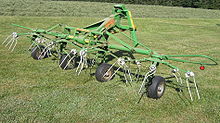
Hay is grass, legumes, or other herbaceous plants that have been cut and dried to be stored for use as animal fodder, either for large grazing animals raised as livestock, such as cattle, horses, goats, and sheep, or for smaller domesticated animals such as rabbits and guinea pigs. Pigs can eat hay, but do not digest it as efficiently as herbivores do.

A tractor is an engineering vehicle specifically designed to deliver a high tractive effort at slow speeds, for the purposes of hauling a trailer or machinery such as that used in agriculture, mining or construction. Most commonly, the term is used to describe a farm vehicle that provides the power and traction to mechanize agricultural tasks, especially tillage, and now many more. Agricultural implements may be towed behind or mounted on the tractor, and the tractor may also provide a source of power if the implement is mechanised.

In agriculture, a harrow is a farm implement used for surface tillage. It is used after ploughing for breaking up and smoothing out the surface of the soil. The purpose of harrowing is to break up clods and to provide a soil structure, called tilth, that is suitable for planting seeds. Coarser harrowing may also be used to remove weeds and to cover seed after sowing.

A reaper is a farm implement or person that reaps crops at harvest when they are ripe. Usually the crop involved is a cereal grass. The first documented reaping machines were Gallic reapers that were used in Roman times in what would become modern-day France. The Gallic reaper involved a comb which collected the heads, with an operator knocking the grain into a box for later threshing.
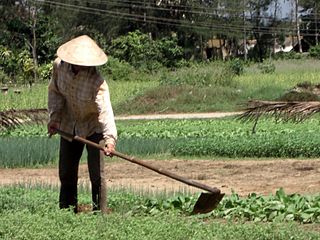
A hoe is an ancient and versatile agricultural and horticultural hand tool used to shape soil, remove weeds, clear soil, and harvest root crops. Shaping the soil includes piling soil around the base of plants (hilling), digging narrow furrows (drills) and shallow trenches for planting seeds or bulbs. Weeding with a hoe includes agitating the surface of the soil or cutting foliage from roots, and clearing the soil of old roots and crop residues. Hoes for digging and moving soil are used to harvest root crops such as potatoes.

A baler or hay baler is a piece of farm machinery used to compress a cut and raked crop into compact bales that are easy to handle, transport, and store. Often, bales are configured to dry and preserve some intrinsic value of the plants bundled. Different types of balers are commonly used, each producing a different type of bale – rectangular or cylindrical, of various sizes, bound with twine, strapping, netting, or wire.

A pitchfork or hay fork is an agricultural tool used to pitch loose material, such as hay, straw, manure, or leaves. It has a long handle and usually two to five thin tines designed to efficiently move such materials.

A garden fork, spading fork, or digging fork is a gardening implement, with a handle and a square-shouldered head featuring several short, sturdy tines. It is used for loosening, lifting and turning over soil in gardening and farming, and not to be confused with the pitchfork, a similar tined tool used for moving loose materials such as hay, straw, silage, and manure.

Threshing, or thrashing, is the process of loosening the edible part of grain from the straw to which it is attached. It is the step in grain preparation after reaping. Threshing does not remove the bran from the grain.

A rake is a broom for outside use; a horticultural implement consisting of a toothed bar fixed transversely to a handle, or tines fixed to a handle, and used to collect leaves, hay, grass, etc., and in gardening, for loosening the soil, light weeding and levelling, removing dead grass from lawns, and generally for purposes performed in agriculture by the harrow.
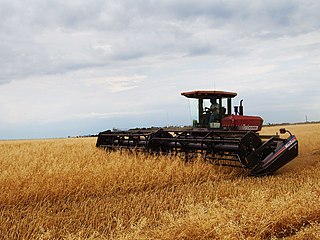
A swather, or windrower, is a farm implement that cuts hay or small grain crops and forms them into a windrow for drying.

A cultivator is a piece of agricultural equipment used for secondary tillage. One sense of the name refers to frames with teeth that pierce the soil as they are dragged through it linearly. It also refers to machines that use the rotary motion of disks or teeth to accomplish a similar result. The rotary tiller is a principal example.

A hay rake is an agricultural rake used to collect cut hay or straw into windrows for later collection. It is also designed to fluff up the hay and turn it over so that it may dry. It is also used in the evening to protect the hay from morning dew. The next day a tedder is used to spread it again, so that the hay dries more quickly.

A conditioner is a farm implement that crimps and crushes newly cut hay to promote faster and more even drying. Drying the hay efficiently is most important for first cutting of the hay crop, which consists of coarse stalks that take a longer period of time to draw out moisture than finer-textured hays, such as second and subsequent cuttings.
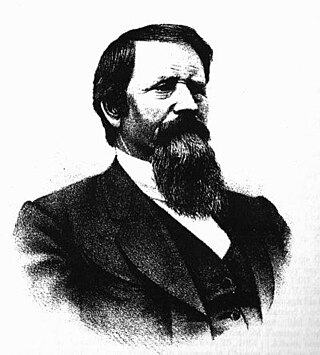
John Samuel Rowell was a noted agricultural inventor and pioneer manufacturer. Born in Springwater, New York, and living his adult life in Beaver Dam, Wisconsin, he held more than 40 patents for farm machinery and agricultural implement improvements, including the patent on the cultivator tooth. He is the great grandfather of Theodore H. Rowell, noted Minnesota pharmaceutical inventor, entrepreneur, and founder of Rowell Laboratories, Inc. Rowell was obsessed with the idea of improving the old methods of soil cultivation. His inventive genius and perseverance enabled him to make his dreams become a reality and become a benefactor to mankind.

Two-wheel tractor or walking tractor are generic terms understood in the US and in parts of Europe to represent a single-axle tractor, which is a tractor with one axle, self-powered and self-propelled, which can pull and power various farm implements such as a trailer, cultivator or harrow, a plough, or various seeders and harvesters. The operator usually walks behind it or rides the implement being towed. Similar terms are mistakenly applied to the household rotary tiller or power tiller; although these may be wheeled and/or self-propelled, they are not tailored for towing implements. A two-wheeled tractor specializes in pulling any of numerous types of implements, whereas rotary tillers specialize in soil tillage with their dedicated digging tools. This article concerns two-wheeled tractors as distinguished from such tillers.
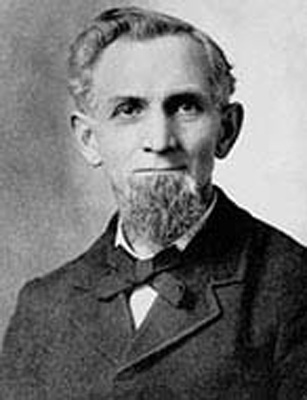
James Murray Spangler was an American inventor, salesman, and janitor who invented the first commercially successful portable electric vacuum cleaner that revolutionized household carpet cleaning. His device was not the first vacuum cleaner, but it was the first that was practical for home use. It was the first to use both a cloth filter bag and cleaning attachments. Spangler improved this basic model and received a patent for it in 1908. He formed the Electric Suction Sweeper Company to manufacture his device. William H. Hoover was so impressed with the vacuum cleaner that he bought into Spangler's business and patents.

John Henry Manny (1825–1856) was the inventor of the Manny Reaper, one of various makes of reaper used to harvest grain in the 19th century. Cyrus McCormick III, in his Century of the Reaper, called Manny "the most brilliant and successful of all Cyrus McCormick's competitors," a field of many brilliant people.

AGCO GmbH is a German manufacturer of agricultural equipment based in Feucht, Germany, located just southwest of Nuremberg in Bavaria. It was established in 1918 as a harrow manufacturing company, and its product line has expanded since.





